After there having been a few messages through the email distribution system of the Lübeck observatory, by a few people who want to go out for observation, there is an addendum that they intend to go west of the city of Lübeck to avoid its light dome. I contribute the idea of going to the army training area “Wüstenei” near Eckhorst. I had been there before to try to capture the comet, and the place is cleared of snow.
The answer is that the other actives have already agreed to meet up at the site of the former outpost of the observatory near Fliegenfelde, but may relocate afterwards. I am thinking there is nothing like doing things thoroughly and throw the C11 with all its accessories into the trunk and drive out towards Eckhorst. Halfway there, I notice I forgot to pack my red light, but it is too late now. Reaching my destination, I also notice that I forgot to set Starry Night to Daylight Saving and am therefore in place an hour early. Hooray.
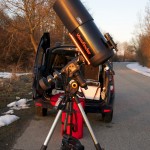 I use the not-planned-for residual daylight to set up at my leisure and observe the sun going down behind a row of trees. The mount is roughly aligned using the compass built into my smartphone. Then, I watch for Jupiter, which should the the first object visible in the sky. Naturally, that takes a while, but around the time I had expected to lose the comet behind the trees, I do see the planet and use it to roughly align my telescope mount. A look through the viewfinder shows me that the northwestern horizon is still way too bright. The orientation point for PANSTARRS C/2011 L4 currently is M31 (the Andromeda Galaxy), in whose direct neighbourhood it should be. In the counterlight from the sunset, it is, of course, totally hopeless to find the galaxy. Still, the comet is supposed to still have Magnitude 4.8. At a reasonable darkness, it should be visible as a tiny speck of light, then.
I use the not-planned-for residual daylight to set up at my leisure and observe the sun going down behind a row of trees. The mount is roughly aligned using the compass built into my smartphone. Then, I watch for Jupiter, which should the the first object visible in the sky. Naturally, that takes a while, but around the time I had expected to lose the comet behind the trees, I do see the planet and use it to roughly align my telescope mount. A look through the viewfinder shows me that the northwestern horizon is still way too bright. The orientation point for PANSTARRS C/2011 L4 currently is M31 (the Andromeda Galaxy), in whose direct neighbourhood it should be. In the counterlight from the sunset, it is, of course, totally hopeless to find the galaxy. Still, the comet is supposed to still have Magnitude 4.8. At a reasonable darkness, it should be visible as a tiny speck of light, then.
During dawn, one of the colleagues from the observatory rings me up and tells me that he has just arrived at Fliegenfelde and is waiting for the colleague he has made the appointment with; he will call again later to tell me whether they will relocate, after that other colleague arrives. Meanwhile, I begin to make out the first stars in the sky, even if the dawn phase of nightfall feels as if it lasts three eternities. I view Jupiter through the telescope; at small magnifications, the Big Guy looks incredibly sharp and clear, with all four Galileian moons. I enjoy that for a while, then try to take a few pictures. That works out OK, but the limitations of the “fat” camera under the given circumstances are revealed mercilessly. There is still way too much residual light; the longer exposures show a kind of light tunnel towards the object.
The northwesterly horizon slowly turns dark, and I try to find the comet, with little success at first. The mount is obviously not yet aligned well enough. I wait another eternity until I can finally see Polaris clearly and polar align the mount a little more accurately than possible using Jupiter. Since I already have the ‘scope pointing at a pretty bright star, I then use the Bahtinov mask to focus the telescope with the camera: this is the first time I have actually done this thoroughly. After four attempts, I decide it will not be getting any better and once more aim at M31. Still nothing to see there. I use the viewfinder to seek around in the vicinity of the theoretical position of the galaxy when I am temporarily blinded by the lights of an approaching VW T4. The van goes past me into the military exclusion zone. Following it, a dog sniffs around, but it is very polite and does not go anywhere near me.
| First attempt | Second attempt | Third attempt | Not going to get better today |
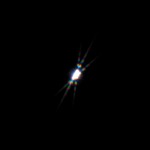 |
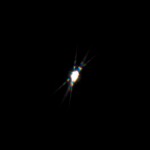 |
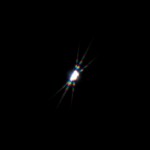 |
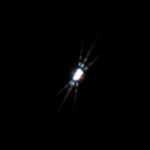 |
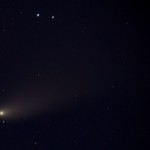 After a few more minutes, I finally have a diffuse object in the viewfinder when the VW van comes back and stops behind me. The driver asks me what I am doing here. I explain that I am trying to take a picture of a comet, and that his driving lights are making that impossible. He explains that he is the owner of the local hunting license, has absolutely no idea about astronomy, but if I want to get a better viewing spot, I should contact him. I thank him: this could give me the opportunity to actually set up inside the forbidden area, where there are a few fine spots if I can read a map right. The hunter and his dog move on, and I follow a hunch on where the comet might be hiding. Right–after only a short search, I get a diffuse object in my viewfinder which could be either M31 or the comet. I let loose with a 20 second exposure and am elated: it is the comet. Which I then take pictures of at various exposure times and ISO settings in the hope of getting a good picture. Towards the end, I take a series of 30 second exposures at ISO 800, which I intend to stack later on.
After a few more minutes, I finally have a diffuse object in the viewfinder when the VW van comes back and stops behind me. The driver asks me what I am doing here. I explain that I am trying to take a picture of a comet, and that his driving lights are making that impossible. He explains that he is the owner of the local hunting license, has absolutely no idea about astronomy, but if I want to get a better viewing spot, I should contact him. I thank him: this could give me the opportunity to actually set up inside the forbidden area, where there are a few fine spots if I can read a map right. The hunter and his dog move on, and I follow a hunch on where the comet might be hiding. Right–after only a short search, I get a diffuse object in my viewfinder which could be either M31 or the comet. I let loose with a 20 second exposure and am elated: it is the comet. Which I then take pictures of at various exposure times and ISO settings in the hope of getting a good picture. Towards the end, I take a series of 30 second exposures at ISO 800, which I intend to stack later on.
 Since the comet is getting ever closer to the horizon, I put in an exposure at ISO 1600, knowing full well that that will give me a very noisy picture, but I don’t care, I am happy to finally be able to take serious pictures of the comet. Meanwhile, it has turned bitterly cold, but the success with the comet gives me the energy to try a few other classics. I move over to M42, the Great Orion Nebula, of which I then take another series of exposures, hoping to have a few usable ones in the bunch. After 11 pictures, I use Pocket Universe to see where several globular clusters are and find that while M5 is not up yet, M3 could be worth a try. In this, I only barely escape the treetops, but have a clear field of view. Theoretically. Later on, I do notice that the corrector disc of my telescope has begun to fog up. Accordingly, the image material is somewhat diffuse.
Since the comet is getting ever closer to the horizon, I put in an exposure at ISO 1600, knowing full well that that will give me a very noisy picture, but I don’t care, I am happy to finally be able to take serious pictures of the comet. Meanwhile, it has turned bitterly cold, but the success with the comet gives me the energy to try a few other classics. I move over to M42, the Great Orion Nebula, of which I then take another series of exposures, hoping to have a few usable ones in the bunch. After 11 pictures, I use Pocket Universe to see where several globular clusters are and find that while M5 is not up yet, M3 could be worth a try. In this, I only barely escape the treetops, but have a clear field of view. Theoretically. Later on, I do notice that the corrector disc of my telescope has begun to fog up. Accordingly, the image material is somewhat diffuse.
 After my viewfinder, too, has completely fogged up I begin to disassemble my gear. My hands get extremely cold, since the finer bits of that task cannot be done wearing gloves. I pack everything up, drive home and start cursing upon seeing that all parking spots anywhere near my apartment are taken. I drive around the back to the garage lot of the house next to mine (there is a throughway to my back yard) to put my gear back into the basement, and by the time I have finished that, a reasonable parking spot has become available.
After my viewfinder, too, has completely fogged up I begin to disassemble my gear. My hands get extremely cold, since the finer bits of that task cannot be done wearing gloves. I pack everything up, drive home and start cursing upon seeing that all parking spots anywhere near my apartment are taken. I drive around the back to the garage lot of the house next to mine (there is a throughway to my back yard) to put my gear back into the basement, and by the time I have finished that, a reasonable parking spot has become available.
There is some time left before I am expected to get online to meet friends, so I look over the catch of the day and process whatever I can. A pretty good picture of the comet is then presented to said friends, and subsequently emailed to a few of them in high resolution. The pictures of M42 are OK, but not exactly breathtaking. I process them later and notice that my optics must have been fogging up even while I was taking the pictures; I try to get the best out of the result. The detail becomes less and less detailed from expoure to exposure. Pity, really; I had planned to do something with that stuff. The series of exposures of M3 is just plain mush.
Despite the failures, the pictures of the comet alone justify the freezing and the time spent. Should the opportunity present itself, I shall repeat.
